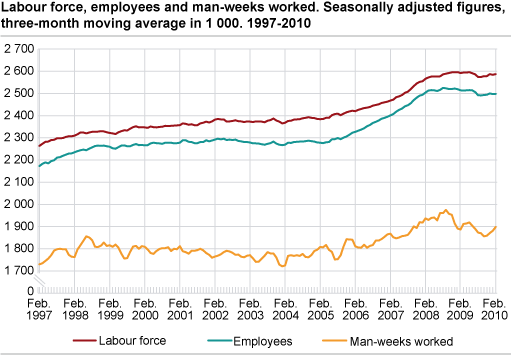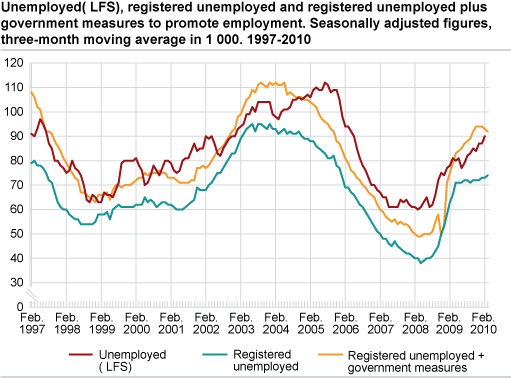Content
Published:
This is an archived release.
Decrease in full-time employees
From the 1st quarter of 2009 to the 1st quarter of 2010 there was a reduction of 21 000 full-time employees. The biggest reduction was among women.
Seasonally-adjusted figures: increasing unemploymentIn February, the unemployed constituted 3.5 per cent of the labour force. This is an increase of 0.2 per cent from November. Employment remained stable. Adjustments for seasonal variations allow for the analysis of current developments in the labour market, and serve as an alternative to comparisons with the corresponding quarter in the previous year. Seasonally-adjusted figures are presented in a separate article . |
The decrease in full-time employees was made up of 14 000 women and 7 000 men. The level of part-time employees remained stable throughout the period.
From the 1st quarter of 2009 to the 1st quarter of 2010 total employment was reduced by 20 000 persons; 16 000 of which were women. The manufacturing industry has had the biggest decrease in employment. From the 1st quarter of 2009 to the corresponding quarter of 2010 the number of employees was reduced by 20 000, which constitutes 8 per cent of the employees in manufacturing. There were only minor changes in the remaining industries.
The number of persons on temporary contracts remained stable throughout the period.
From the 1st quarter of 2009 to the 1st quarter of 2010 there was a reduction of 14 000 persons reporting own illness as reason for absence in the whole reference week. In the 1st quarter of 2010, a total of 89 000 persons reported own illness as their reason for absence.
Lower labour force participation amongst the young
In the 1st quarter of 2010, the labour force participation rate (the sum of employees and unemployed) in Norway was 71.8 per cent; down 1.2 per cent from the corresponding quarter in 2009. The decrease is particularly high among the young part of the population. Within the last year, all age groups under 30 have had their labour force participation reduced by 2 to 3 percentage points. The age group 30-39 has also had a reduction in labour force participation.

More long-term unemployed
According to the LFS, the number of unemployed increased by 16 000 people between the 1st quarter of 2009 and the 1st quarter of 2010. The increase was similar for men and women and was among the long-term unemployed. The share of long-term unemployed rose from 19 per cent in the 1st quarter of 2009 to 32 per cent in the 1st quarter of 2010. Long- term unemployed is defined as people who have been out of work for more than 26 weeks. Of a total of 95 000 unemployed persons in the 1st quarter of 2010, 31 000 were long-term unemployed.
The labour force is the sum of employed and unemployed between 15-74 years of age. From the 1st quarter of 2009 to the 1st quarter of 2010 the LFS shows a decline in employment of 20 000, while there is an increase in unemployment of 16 000. This represents a decline in the labour force of 4 000. The coherence between the conceptsUnemployed + Employed = Labour force Labour force + Outside the labour force = Population |

A new industry classification was introduced as from the publication of the first quarter of 2009. Here is an article presenting general information about the new Norwegian industry classification .
Stable number of under unemployed
The number of underemployed was 63 000 in the 1st quarter of 2010, which is the same level as the 1st quarter of 2009. Underemployment is employees with part-time contracted working hours who have tried to find more work. The group of underemployed and unemployed as a whole wanted work corresponding to 104 000 man-weeks in the 1st quarter of 2010; up 14 000 from the year before.
Outside the labour force
The labour force was reduced by 4 000 people between the 1st quarter of 2009 and the 1st quarter of 2010. This is within the error margin of the LFS. In the same period, the population rose by 56 000 persons, which gives a total increase of people outside the labour force of 60 000. From the 1st quarter of 2009 to the 1st quarter of 2010 there is an increase of 19 000 people outside the labour force who reports studies as their main activity. In the same period, there is an increase of 24 000 people who report different types of retirement as their main activity.
Tables
- Table 1. Population aged 15-74 by labour force status(LFS) and sex. 1 000
- Table 2. Population aged 15-74 by labour force status(LFS) and sex. Changes in 1 000
- Table 3. Population aged 15-74 by labour force status(LFS) and sex. Per cent
- Table 4. Persons in the labour force and employed persons aged 15-74, by age and sex (LFS). 1 000
- Table 5. Persons in the labour force and employed persons aged 15-74, by age and sex (LFS). In per cent of the population
- Table 6. Persons aged 15-74, employed persons by contractual/usual working hours per week 1 and unemployedpersons by age and sex (LFS). 1 000
- Table 7. Persons in the labour force aged 15-74 by age and sex (LFS). 1 000. 1 000
- Table 8. Persons in the labour force aged 15-74 by age and sex (LFS). As per cent of all in each group'
- Table 9. Employed persons aged 15-74 by sex and contractual/usual working hours per week (LFS). 1 000
- Table 10. Population aged 15-74, by main activity, part-time employment and age (LFS). 1 000
- Table 11. Employed persons aged 15-74 by major industry division (LFS). 1 000
- Table 12. Number of man-hours worked per week2, by industry division (LFS). 1 000
- Table 13. Employed persons aged 15-74, total, and employed persons at work by status and sex. Number of man-weeks worked 1 and actual working hours per week (LFS). 1 000
- Table 14. Employed persons aged 15-74 and absence from work 1 during the whole reference weekby reason for absence and sex (LFS). 1 000
- Table 15. Employed persons aged 15-74 and absence from work 1 during the whole reference weekby reason for absence and sex (LFS). Per Cent
- Table 16. Employees aged 15-74 with temporary jobs, by major industry division (LFS). 1 000
- Table 17. Employees aged 15-74 with temporary jobs, by major industry division (LFS).In per cent of all employees
- Table 18. Unemployed persons aged 15-74 by sex and age (LFS). 1 000 and per cent
- Table 19. Unemployed persons aged 15-74 by duration of job search (LFS). 1 000 and per cent
- Table 20. Unemployed persons aged 15-74, by main activity (LFS). 1 000
- Table 21. Unemployed and underemployed persons aged 15-74, by sex and desired working hours per week.Number of man-weeks (of 37,5 hours) supplied'
- Table 22. This table is omitted. More information are presented in a separate article
- Table 23. Employed persons aged 15-74, by sex and region (LFS) 1 000
- Table 24. Employed persons aged 15-74, by sex and regions (LFS) as per cent of all inn each group
Contact
-
Arbeidsmarked og lønn
E-mail: arbeidsmarked@ssb.no
-
Erik Herstad Horgen
E-mail: erik.horgen@ssb.no
tel.: (+47) 93 08 68 62
-
Håvard Hungnes Lien
E-mail: havard.lien@ssb.no
tel.: (+47) 40 90 26 06
